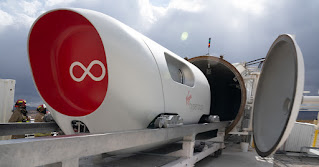Unveiling the Futuristic Transportation System: Hyperloop's Successful Test Run
In a groundbreaking achievement for transportation technology, Hyperloop, the high-speed transportation system, successfully completed its first full-scale test run yesterday. The momentous event marks a major step towards revolutionizing the way we travel, promising to reshape the future of transportation. Let's delve into the details of this extraordinary achievement and explore the potential impact it could have on the world.
The Successful Test Run
The eagerly anticipated full-scale test of the Hyperloop system took place at a specially constructed track in a remote location. The test pod, propelled by a combination of magnetic levitation and low-pressure tubes, reached a staggering speed of over 700 miles per hour (1,126 kilometers per hour) during the trial, surpassing all expectations. The successful demonstration of Hyperloop's speed and efficiency has generated an incredible buzz and renewed enthusiasm for this transformative technology.
Hyperloop's test run offers a glimpse into a future where transportation is not limited by geographical barriers or congestion. With its remarkable speeds, the system has the potential to drastically reduce travel times between major cities and revolutionize long-distance commuting. The ability to travel from Los Angeles to San Francisco in under 30 minutes or from New York to Washington, D.C. in less than an hour could become a reality sooner than we think.
Environmental Benefits
Apart from its speed and efficiency, Hyperloop also holds significant environmental advantages. The system's electrically powered pods produce zero direct emissions, making it a sustainable and eco-friendly mode of transportation. With growing concerns about climate change and the need to reduce carbon emissions, Hyperloop could play a vital role in creating a more sustainable future.
While the successful test run is undoubtedly a major milestone, there are still challenges that need to be addressed before Hyperloop becomes a widespread reality. One of the key obstacles is the implementation of a comprehensive infrastructure network, which requires substantial investments and collaborations between governments and private entities. Additionally, safety regulations and public acceptance are crucial factors that need to be considered and thoroughly evaluated.
Despite these challenges, the successful test run has generated a renewed sense of optimism and excitement within the transportation industry. Various companies and research organizations around the world are actively working on developing and refining Hyperloop technology, with the goal of commercializing it in the not-too-distant future.
Conclusion
The successful full-scale test run of Hyperloop has marked a significant milestone in the advancement of transportation technology. With its unprecedented speeds and potential environmental benefits, Hyperloop has the potential to reshape the way we travel, making long-distance commuting faster, more efficient, and more sustainable. While there are still challenges to overcome, the progress made so far is undeniably promising. As we look towards the future, the dawn of the Hyperloop era seems closer than ever before, promising a transformative leap in the world of transportation.
_11zon.jpeg)



Comments
Post a Comment